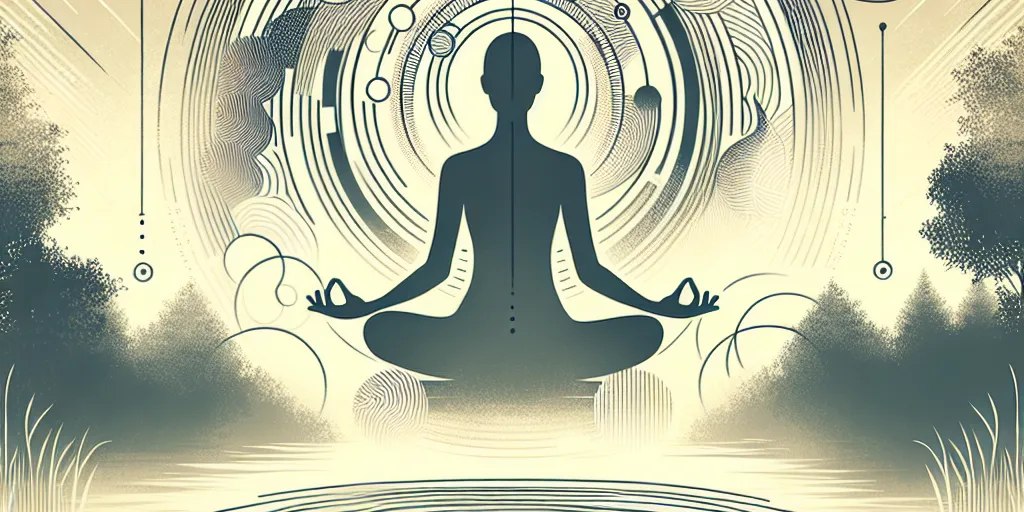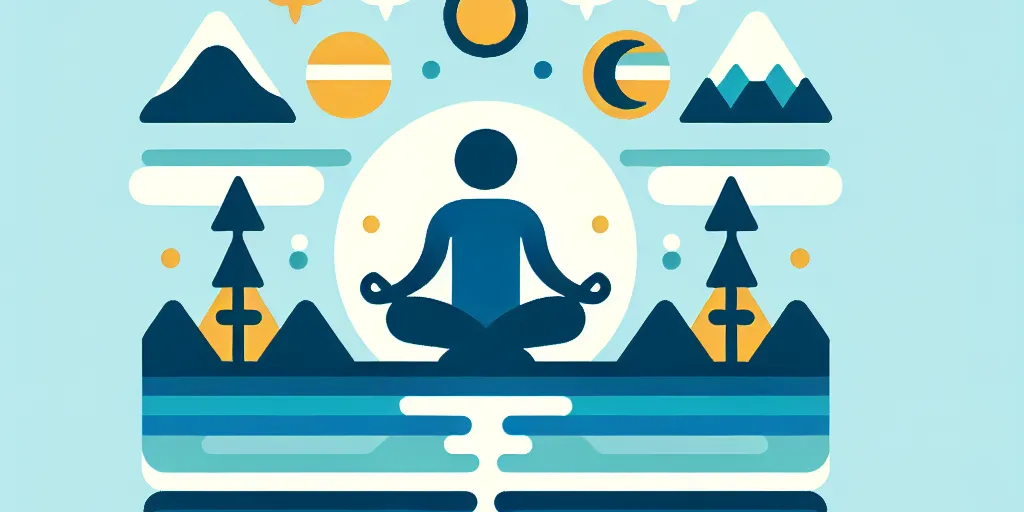· Seren Marlowe · wellness and balance · 8 min read
Mindfulness Mastery: Embracing the Present Moment
Unlock the Power of Now

Let’s take a deep breath and dive into the world of mindfulness together. In today’s hustle and bustle, it’s easy to lose sight of the present moment—the here and now where life actually happens. That’s where mindfulness comes in, as a beacon of tranquility in the choppy seas of daily life. Whether you’re a seasoned meditator or a curious newbie, this post is your gentle nudge towards a more mindful existence.
Eager to explore the different facets of mindfulness? Let’s peek at what we’ve got lined up for you in this post:
- A Brief History of Mindfulness
- Mindfulness in the Digital Age: Finding Focus
- Mindful Breathing: The Gateway to Serenity
- The Science Behind Mindfulness: Benefits for Mind and Body
- Mindfulness Meditation: A Step-by-Step Guide
- Incorporating Mindfulness into Daily Activities
- Overcoming Challenges on the Path to Mindfulness
A Brief History of Mindfulness
The practice of mindfulness has its roots in ancient traditions, stretching back thousands of years. Primarily anchored in Buddhism, mindfulness—known as ‘sati’ in Pali—was essential in the path to enlightenment. In these early days, mindfulness involved deep meditation and a keen awareness of one’s thoughts and feelings.
Mindfulness spread from the Eastern traditions to the Western world in a more secular form, thanks to influential figures such as Jon Kabat-Zinn. His work led to the foundation of the Mindfulness-Based Stress Reduction (MBSR) program in the 1970s, which brought mindfulness into the mainstream of medicine and psychology.
The best way to capture moments is to pay attention. This is how we cultivate mindfulness. — Jon Kabat-Zinn
Today, mindfulness has transcended cultural boundaries and taken on a universal appeal. It is celebrated as a practical tool for managing stress, enhancing emotional intelligence, and improving overall well-being, regardless of one’s spiritual beliefs.
Mindfulness in the Digital Age: Finding Focus
 In the constantly connected world of smartphones and social media, our attention is pulled in a million directions. The Digital Age has brought about incredible advancements, but it has also introduced unprecedented levels of distraction. Mindfulness in the digital era has become a sanctuary for many seeking to regain control over their focus and peace of mind.
In the constantly connected world of smartphones and social media, our attention is pulled in a million directions. The Digital Age has brought about incredible advancements, but it has also introduced unprecedented levels of distraction. Mindfulness in the digital era has become a sanctuary for many seeking to regain control over their focus and peace of mind.
Finding focus amidst digital chaos requires intentional practices. It’s about learning to notice when you’re getting sucked into digital distractions and choosing to pause and breathe. Bringing a sense of mindfulness to our interactions with technology can help us form a healthier relationship with our devices, using them as tools rather than letting them use us.
By setting specific times to check emails or social media, or even going on digital detoxes, we can create spaces of silence and presence in our day. Mindfulness in the Digital Age doesn’t mean rejecting technology—it’s about finding balance and staying anchored in the here and now, even amidst the constant buzz of our digital lives.
Mindful Breathing: The Gateway to Serenity
Mindful breathing is the cornerstone of mindfulness practice. It’s often referred to as the gateway to serenity because it’s a simple yet powerful technique accessible to anyone, anywhere. The premise is straightforward: you focus your attention solely on the breath’s natural rhythm, observing each inhale and exhale without judgment or alteration.
By anchoring your awareness to the breath, mindful breathing allows you to ground yourself in the present moment. It acts as a bridge, connecting the mind and body, and provides a refuge from the torrent of thoughts that often dominate our inner landscape.
Practicing mindful breathing can be as simple as taking five deep breaths during moments of stress or dedicating a few minutes each day to sit quietly and observe your breathing. This practice helps to cultivate a profound sense of calm and can significantly reduce anxiety levels, leading to better focus, improved decision-making, and an overall sense of well-being.
The Science Behind Mindfulness: Benefits for Mind and Body
The benefits of mindfulness are not just anecdotal; science has begun to shed light on its profound impact on both the mind and body. Neuroscience research shows that mindfulness practices can physically change the structure of the brain. Regions associated with attention, emotional regulation, and self-awareness are strengthened, while activity in the amygdala—our fear and stress center—decreases.
On a psychological level, mindful individuals often report higher levels of happiness and contentment. Regular practice is linked to decreases in anxiety, depression, and irritability, creating a more stable emotional climate.
When it comes to the body, mindfulness has been shown to lower blood pressure, improve sleep, and bolster the immune system. It’s also credited with reducing chronic pain and enhancing the body’s ability to heal.
Mindfulness isn’t difficult, we just need to remember to do it.
— Sharon Salzberg
Empirical studies continue to uncover the myriad of ways in which mindful living can enhance and extend our lives. It’s a testament to the innate power we hold within to shape our own well-being through the simple act of being present.
Mindfulness Meditation: A Step-by-Step Guide
 Embarking on the practice of mindfulness meditation can be both exhilarating and intimidating. But fear not—here’s a simple step-by-step guide to get you started on your journey to inner peace:
Embarking on the practice of mindfulness meditation can be both exhilarating and intimidating. But fear not—here’s a simple step-by-step guide to get you started on your journey to inner peace:
- Find a Quiet Space: Select a place free from distractions. Use a cushion or chair to sit comfortably.
- Set a Time Limit: Especially for beginners, starting with just 5-10 minutes can be beneficial.
- Pay Attention to Your Body: Notice your posture and bodily sensations. Feel grounded in your seat.
- Feel Your Breath: Focus on the physical sensation of breathing. Explore the rhythm of your breath without trying to change it.
- Notice When Your Mind Has Wandered: It’s natural for thoughts to arise. Gently return your focus to your breath each time.
- Be Kind to Your Wandering Mind: Don’t judge yourself for distractions. Acknowledge them and return to your breath.
Consistency is more important than duration. Over time, as you build your practice, you can extend the length of your sessions. The key to mindfulness meditation is not in the length of time spent, but in the quality of your awareness during the practice. Be patient and gentle with yourself—it’s a practice, after all, and every moment is a new opportunity to be present.
💡 Motivation is the soul’s compass, guided by the magnetic force of purpose. Within the intricate dance of neurons, the nucleus accumbens orchestrates a symphony of determination, releasing dopamine with every step towards a dream. It’s a reminder that within ourselves lies the potent spark that ignites the fire of relentless pursuit.
Incorporating Mindfulness into Daily Activities
Incorporating mindfulness into daily activities transforms ordinary moments into ones of awareness and presence. It’s about engaging fully with the task at hand, be it brushing your teeth or eating lunch. Here’s how you can weave mindfulness throughout your day:
- Morning Routine: As you wake up, take a moment to stretch and breathe deeply, setting a calm tone for the day.
- Mindful Eating: Savor each bite, noticing flavors, textures, and sensations, to turn meals into a sensory experience.
- Active Listening: In conversations, focus completely on the other person, which fosters deeper connections and understanding.
By doing these simple actions, you’ll find that mindfulness becomes less of something you do and more of the way you live. When you start to pay attention, every moment has the potential to become a mindful one, nurturing a sense of peace and stillness in your life, no matter what’s happening around you.
Overcoming Challenges on the Path to Mindfulness
The journey towards cultivating mindfulness isn’t without its hurdles. Many encounter obstacles such as wandering thoughts, lack of time, or simply forgetting to be mindful. But don’t be deterred—each challenge is a stepping stone to greater self-awareness.
To overcome distractions, acknowledge them without judgement. Remind yourself that the essence of mindfulness is returning to the present, no matter how many times the mind drifts. If time is a concern, start small. Even a minute of conscious breathing is valuable.
It isn’t what happens to us that causes us to suffer; it’s what we say to ourselves about what happens. — Pema Chödrön
Creating triggers, like mindful reminders at certain times or places, can help you remember to pause and check in with the present. Be patient and compassionate with yourself as you navigate this path. Remember, every moment is a new chance to practice mindfulness. Embrace each one as an opportunity to cultivate a deeper sense of peace and clarity in your life.
And there we go, my mindful friend—you’ve just taken a refreshing journey through mindfulness together with us. Remember that mindfulness isn’t a destination; it’s a way of traveling. Keep these insights close to your heart as you continue your adventure in the present moment. Stay mindful, and see you on the path!





